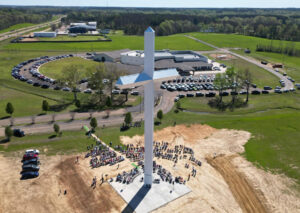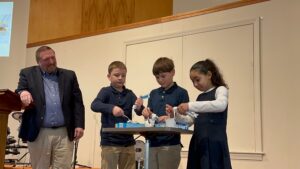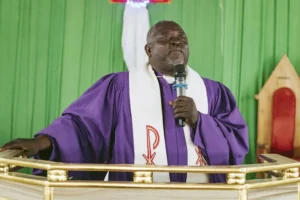
 Seen from the highway into Reed City, Michigan, an impressive twelve-foot cross erected on the grounds beckoned me to tour The Old Rugged Cross Museum and Historical Society. Inside I discovered an old upright piano that belonged to George Bennard and his wife Hannah. Nestled in its open case against the wall was his guitar. The now quiet clock sat on top of the piano.
Seen from the highway into Reed City, Michigan, an impressive twelve-foot cross erected on the grounds beckoned me to tour The Old Rugged Cross Museum and Historical Society. Inside I discovered an old upright piano that belonged to George Bennard and his wife Hannah. Nestled in its open case against the wall was his guitar. The now quiet clock sat on top of the piano.
As I played “The Old Rugged Cross” on that weathered Hinze piano, I recalled childhood memories of my own composer dad sitting at the baby grand, staff paper on the fallboard, pencil behind his ear, deciding which chord progression or rhythm would fit with the words he had jotted down on a bulletin or a scrap of paper. I imagined Bennard, strumming the chords on his guitar, composing “The Old Rugged Cross” like that.
NEVER BOAST EXCEPT IN THE CROSS
(Galatians 6:14a, NIV)
Reflecting on Galatians 6:14 to gain a fuller understanding of the cross, Bennard, a full-time evangelist, wrote, “I read and studied and prayed. . . . The Christ of the Cross became more than a symbol. . . . It was like seeing John 3:16 leave the printed page, take form, and act out the meaning of redemption. While watching this scene with my mind’s eye, the theme of the song came to me.” 1
A melody was born in his mind. He spent several weeks penning the words, completing “The Old Rugged Cross” during a two-week revival meeting in Sturgeon Bay, Wisconsin, in late December 1912 and early January 1913. He and music evangelist Ed Mieras sang the finished song to a full house on the final night of the meeting. A few months later, after help on the harmonies by fellow–composer Charles H. Gabriel, the completed version was sung by a small choir accompanied by a guitar.
“The Old Rugged Cross” quickly became a cherished hymn “because of what the cross means to Christians,” said Greg Brewton, associate dean of music and worship leadership at Southern Baptist Theological Seminary. “Why would the Son of God give His life for fallen sinners?” he mused. “Second Corinthians 5:21 tells us that Christ, who knew no sin, became sin for us so that we might become His righteousness. It was on the cross that Christ bought our redemption. A place of crucifixion became a cherished place of salvation for those of us in Christ.”
SING HIM A NEW SONG
(Psalm 33:3a, NIV)
In 2005, Keith Getty and fellow composer Stuart Townend co-wrote “The Power of the Cross.” I’ll never forget the first time I heard it—a tune melodically married to the text in such a worshipful way:
“This the power of the cross;
Son of God—Slain for us.
What a love, what a cost!
We stand forgiven at the cross.”
I was unable to sing, overcome with the impact of these words. As Getty put it, “Hymn writing is neither theological propaganda nor is it a teaching tool; it’s an art form. In every form of art, one person shapes something in a way that makes all of us breathe deeper and want to live better.”2
In a similar way, new to the listener’s ears in 1913 with its flowing melody and simple rhythm, “The Old Rugged Cross” tugged at people’s hearts and became one of the best loved hymns of the twentieth century. Early recordings by Homer Rodeheaver were often played on Billy Sunday’s radio programs, which helped popularize it. George Beverly Shea, long-time soloist with the Billy Graham Evangelistic Association, saw Bennard many times at the Winona Lake Bible conferences in Indiana, and spoke often of how moved he was the first time he heard him sing “The Old Rugged Cross.”
It has been translated into many languages, attracting tour groups from around the world to the small museum. “We have people come here from all over the world,” Betsy Randall, the museum director, said. “Sometimes they have their own worship services. We just let them sing.”
The hymn has been recorded by more than two dozen of the twentieth-century’s most important American recording artists and groups, including Shea. Its popularity has led to its inclusion in every major hymnal published by Southern Baptists since the hymn’s composition (1926, 1940, 1956, 1975, 1991, and 2008).
I WILL SING OF THE LORD'S GREAT LOVE FOREVER
(Psalm 89:1, NIV)
Friends of mine, faithful in leading worship in nursing homes, have indicated “The Old Rugged Cross” is the most requested song from the senior residents.
They told of an elderly woman whose son wheeled her into the service in a Geri-chair, head slumped forward, eyes unfocused, her body shutting down. Though otherwise unresponsive to her surroundings, when they sang “The Old Rugged Cross,” she mouthed every word. Their experience, multiplied thousands of times across the nation, illustrates the conclusion of Psalm 89:1: with my mouth I will make your faithfulness known through all generations.
One hundred years! The hymn has stood the test of time. Brewton said it well, “The message of ‘The Old Rugged Cross’ never grows old. It’s the Gospel story.” Its timeless message is still relevant to believers today.
“So I’ll cherish the old rugged cross,
Till my trophies at last I lay down;
I will cling to the old rugged cross,
And exchange it someday for a crown.”
1 Cited by Ernest K. Emurian, Hymn Stories for Programs (Grand Rapids: Baker Book House, 1963), pp. 78–79.
2 Keith Getty, “Toward Depth and Beauty: Keith Getty Talks about Hymn Writing,” Southern Seminary Magazine (Fall 2012), p. 25.
















